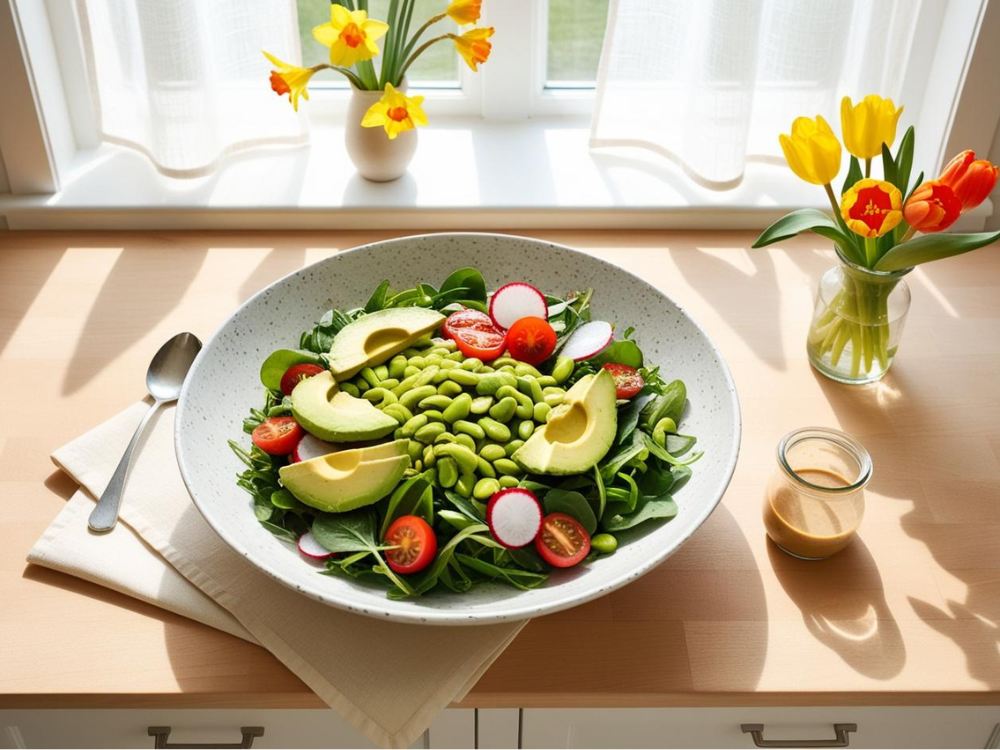Vegetable Quiche
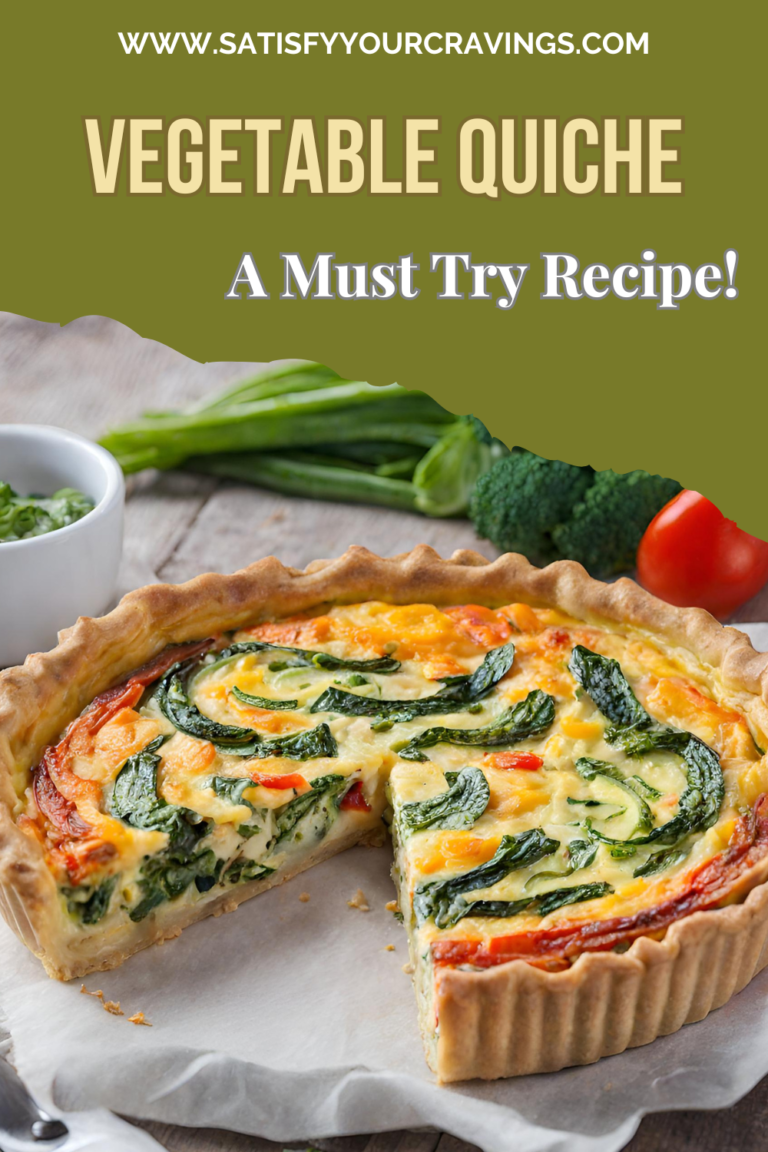
Fresh, Flavorful, and Easy to Make
Quiche is one of those magical dishes that works for any meal—breakfast, brunch, lunch, or dinner. This vegetable quiche is packed with fresh, colorful ingredients like spinach, cherry tomatoes, and bell peppers, all baked to perfection in a flaky, golden crust. It’s a comforting yet wholesome dish that’s surprisingly easy to make and perfect for any occasion. Whether you’re hosting a weekend brunch or looking for a quick meal-prep option, this recipe will hit the spot.
What makes this vegetable quiche truly special is its versatility. You can customize it with your favorite veggies or use it as a great way to clean out the fridge. Pair it with a side salad for a light lunch or serve it with a warm soup for a cozy dinner. No matter how you slice it, this quiche is guaranteed to be a crowd-pleaser. Ready to make this delicious dish? Let’s get started!
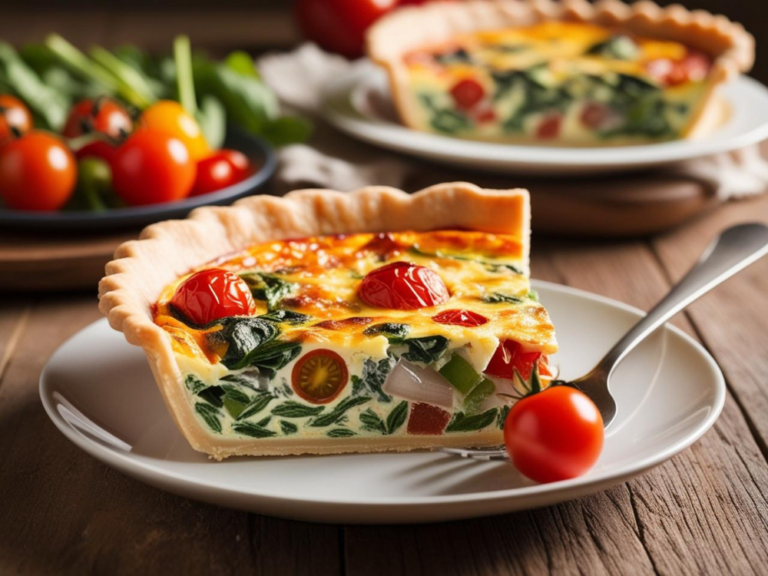
Nutrition Information for Vegetable Quiche
One of the best things about a vegetable quiche is how adaptable it is to fit different dietary preferences while still being packed with nutrients. Not only is it a wholesome meal option, but it also offers a balance of protein, healthy fats, and essential vitamins and minerals to fuel your day. Here’s a detailed breakdown of the nutrition in a typical vegetable quiche and some tips to make it even healthier!
Calories and Macros
A single slice of vegetable quiche (1/8 of a standard 9-inch quiche) typically contains around:
- Calories: 250-300 (depending on the crust and cheese used)
- Protein: 10-12 grams (from eggs, cheese, and milk)
- Carbohydrates: 15-20 grams (mostly from the crust)
- Fat: 15-18 grams (a mix of healthy fats from eggs, cheese, and butter in the crust)
This makes it a well-rounded option, especially when paired with a side salad or fresh fruit.
Vitamins and Minerals
The fresh vegetables in this quiche bring a wealth of vitamins and minerals to the table:
- Spinach: A powerhouse of iron, magnesium, and Vitamin K, essential for strong bones and blood health.
- Cherry Tomatoes: Packed with Vitamin C and antioxidants like lycopene, which help protect your cells from damage.
- Bell Peppers: High in Vitamin A and C, promoting healthy skin and a strong immune system.
- Eggs: Loaded with protein, Vitamin D, and choline, which supports brain and nervous system health.
If you’re adding cheese, it also contributes calcium for strong bones and teeth.
Making It Healthier
There are plenty of ways to adjust this recipe to suit your nutritional needs:
- Lower Calories: Use a crustless option or a gluten-free, low-carb crust made from almond or coconut flour.
- Boost Protein: Add more egg whites or include lean proteins like turkey or tofu.
- Reduce Fat: Swap heavy cream for low-fat milk or a plant-based alternative like almond or oat milk.
- Dairy-Free Option: Replace cheese with nutritional yeast for a cheesy flavor without the dairy, or use a plant-based cheese.
- Increase Fiber: Add more fiber-rich vegetables like broccoli, zucchini, or mushrooms.
Customizing for Special Diets
- Keto-Friendly: Opt for a low-carb crust or skip the crust altogether. Use full-fat dairy for added creaminess while keeping carbs low.
- Gluten-Free: Swap the traditional crust for a store-bought gluten-free crust or make your own using almond flour.
- Vegan: Replace eggs with a chickpea flour mixture or silken tofu, and use plant-based cheese and milk.
Portion Control and Serving Size
Each slice of vegetable quiche is a nutrient-packed meal on its own, but portion control is key if you’re watching your calorie intake. Pair a slice with a side of greens for added fiber and volume without adding extra calories.
Nutritional Benefits of Meal Prep
Quiche is a fantastic option for meal prep, as it stores well in the fridge for up to 4 days. Reheat a slice in the oven or microwave for a quick, balanced meal anytime. Plus, with its blend of veggies, protein, and healthy fats, it keeps you satisfied and energized throughout the day.
By understanding the nutritional value of your vegetable quiche, you can enjoy it guilt-free and make adjustments to suit your personal health goals. It’s a dish that’s not only delicious but also provides your body with the nutrients it needs. Ready to get started? Check out the full recipe and tips above!

The Benefits of Eating Vegetable Quiche
There’s something special about a dish that’s not only delicious but also versatile and nutritious. Vegetable quiche is exactly that—a wholesome, flavor-packed recipe that works for breakfast, brunch, lunch, or dinner. Whether you’re looking for a balanced meal, a quick make-ahead option, or a way to enjoy more vegetables, vegetable quiche delivers on all fronts. Let’s explore why this dish deserves a spot on your menu.
1. A Nutrient Powerhouse
One of the standout benefits of vegetable quiche is its nutrient density. Packed with fresh vegetables like spinach, cherry tomatoes, bell peppers, and onions, it’s loaded with essential vitamins and minerals.
- Spinach adds a boost of iron, magnesium, and Vitamin K to support bone and blood health.
- Cherry Tomatoes provide Vitamin C and antioxidants like lycopene to help protect your cells.
- Bell Peppers are rich in Vitamin A and fiber, promoting healthy digestion and skin.
When combined with protein-rich eggs and calcium-packed cheese, every slice of vegetable quiche becomes a nutrient-packed meal that supports your overall health.
2. A Balanced and Complete Meal
A slice of vegetable quiche is a perfect example of a well-rounded meal. It offers:
- Protein from eggs and cheese to keep you feeling full and energized.
- Healthy fats for sustained energy and flavor.
- Carbohydrates (if you use a crust) for quick energy.
Add the fiber from the vegetables, and you’ve got a dish that satisfies hunger while keeping you nourished.
3. Customizable for Any Diet
The beauty of vegetable quiche lies in its adaptability. You can easily modify it to suit your dietary needs:
- Low-Carb Option: Go crustless or use a low-carb crust made from almond flour.
- Gluten-Free: Swap out traditional crusts for gluten-free alternatives.
- Dairy-Free: Use plant-based cheese and milk alternatives.
No matter your preferences, you can enjoy the delicious flavors of a vegetable quiche while sticking to your health goals.
4. Perfect for Meal Prep
If you’re always on the go, vegetable quiche is a lifesaver. It stores well in the fridge for up to four days and reheats beautifully, making it an excellent option for meal prep. Whether you need a quick breakfast or a light dinner, having a pre-made vegetable quiche ready to go ensures you’re always just minutes away from a balanced, satisfying meal.
5. Suitable for Any Occasion
Few dishes are as versatile as a vegetable quiche. Serve it warm as a hearty breakfast, pair it with a salad for a light lunch, or enjoy it as a quick, satisfying dinner. It’s also an excellent choice for brunch gatherings or potlucks, as it caters to a variety of tastes and dietary preferences.
6. Encourages Healthy Eating
Getting enough vegetables in your diet can be a challenge, but vegetable quiche makes it easy. By combining fresh, colorful veggies with the creamy goodness of eggs and cheese, this dish transforms healthy ingredients into something indulgent. It’s a great way to introduce more vegetables into your family’s diet—especially for picky eaters!
7. A Waste-Free Dish
Have a fridge full of leftover veggies? Toss them into a vegetable quiche! It’s the perfect way to reduce food waste while creating a delicious, nutritious meal. Whether it’s zucchini, mushrooms, or asparagus, almost any vegetable works in this adaptable recipe.
8. Supports Weight Management
Thanks to its balance of protein, fiber, and healthy fats, vegetable quiche is a satisfying meal that can help curb cravings and keep you full longer. For a lighter version, try a crustless quiche or load up on extra veggies while reducing cheese and cream.
9. Fun and Easy to Make
Making a vegetable quiche is a rewarding experience. It’s simple enough for beginners yet customizable for experienced cooks who love experimenting with flavors. Try different vegetable combinations, cheese varieties, or herbs to make each quiche uniquely your own.
10. A Beautiful Dish for Entertaining
With its golden crust and colorful vegetable filling, a vegetable quiche is as visually appealing as it is tasty. It’s a guaranteed crowd-pleaser for brunches, holidays, or casual get-togethers. Plus, it can be made in advance, leaving you more time to enjoy the event.
Conclusion
From its nutrient-packed ingredients to its versatility and ease of preparation, vegetable quiche is a dish that ticks all the boxes. It’s a delicious way to enjoy more vegetables, stay nourished, and make mealtime a breeze. Whether you’re meal prepping, hosting a brunch, or simply craving something hearty and healthy, vegetable quiche is a must-try recipe. Ready to make your own? Check out the full recipe above and discover why this dish is a fan favorite!
Try some of our other recipes!
The History of Quiche: A Delicious Journey Through Time
Quiche is one of those timeless dishes that feels both sophisticated and comforting. Whether it’s served at a fancy brunch or as a quick weekday dinner, this savory pie has captured the hearts (and taste buds) of people worldwide. But where did quiche come from, and how did it evolve into the versatile dish we know today? Let’s take a deep dive into the fascinating history of quiche.
The Origins of Quiche: A French Classic with German Roots
While quiche is often associated with French cuisine, its origins actually trace back to Germany. The word “quiche” is derived from the German word “kuchen,” which means cake. It first appeared in the medieval German kingdom of Lothringen, which later became the French region of Lorraine. When the French adopted the dish, they gave it the name we use today: quiche.
The earliest versions of quiche were quite simple. The original quiche Lorraine consisted of a savory custard made from eggs and cream, baked in a bread dough crust, and topped with smoked bacon or lardons. It was a hearty and humble dish, perfect for sustaining farmers and workers.
Quiche’s Evolution in French Cuisine
As quiche became a staple in French kitchens, chefs began experimenting with variations. Cheese was eventually added to the traditional quiche Lorraine, and regional variations emerged, incorporating local ingredients like onions, mushrooms, and herbs. The dish moved from being a rustic meal to becoming a refined option for brunches and special occasions.
By the 19th and early 20th centuries, quiche had solidified its place as a classic of French cuisine. It was celebrated for its versatility, as it could be made with almost any combination of ingredients. From seafood to vegetables, quiche became a creative outlet for home cooks and professional chefs alike.
The Spread of Quiche to the Rest of the World
Quiche made its way beyond France in the mid-20th century, becoming particularly popular in the United States and the United Kingdom. In the post-World War II era, French cuisine was seen as the pinnacle of sophistication, and quiche became a fashionable dish for dinner parties and gatherings.
In the 1970s and 1980s, quiche enjoyed a surge in popularity in the United States, where it became a brunch staple. This era also saw the rise of the “quiche craze,” as people began to experiment with new fillings and flavor combinations. Spinach and cheese, mushrooms, and even seafood quiches became household favorites.
Modern Quiche: A Dish for Everyone
Today, quiche has truly become a global dish. While the traditional quiche Lorraine remains a classic, modern interpretations cater to a variety of tastes and dietary needs. You’ll find quiches made with gluten-free crusts, vegan custards, and fillings that range from Mediterranean-inspired ingredients like sun-dried tomatoes and feta to Asian-inspired flavors like tofu and sesame.
The popularity of quiche can be attributed to its incredible versatility. It can be served hot or cold, made ahead of time, and customized with almost any ingredients you have on hand. Whether it’s part of a holiday spread or a quick meal-prep option, quiche continues to win over new generations of food lovers.
Quiche’s Cultural Significance
Quiche’s evolution from a simple German dish to an international favorite is a testament to how food transcends borders and cultures. It’s a dish that reflects the creativity and adaptability of cooks around the world, and its enduring popularity proves that good food never goes out of style.
In France, quiche remains a symbol of regional pride, particularly in Lorraine, where the traditional quiche Lorraine originated. For many, making and enjoying quiche is a way of connecting with culinary history while also embracing modern tastes and lifestyles.
Conclusion
The story of quiche is one of humble beginnings, culinary innovation, and global appeal. From its roots in medieval Germany to its transformation into a French classic and its eventual rise as a worldwide favorite, quiche has carved out a unique place in food history. Whether you’re enjoying a slice of vegetable quiche or the traditional quiche Lorraine, you’re part of a rich tradition that spans centuries and continents. Ready to make your own quiche? Explore our recipe and bring a piece of culinary history to your table!
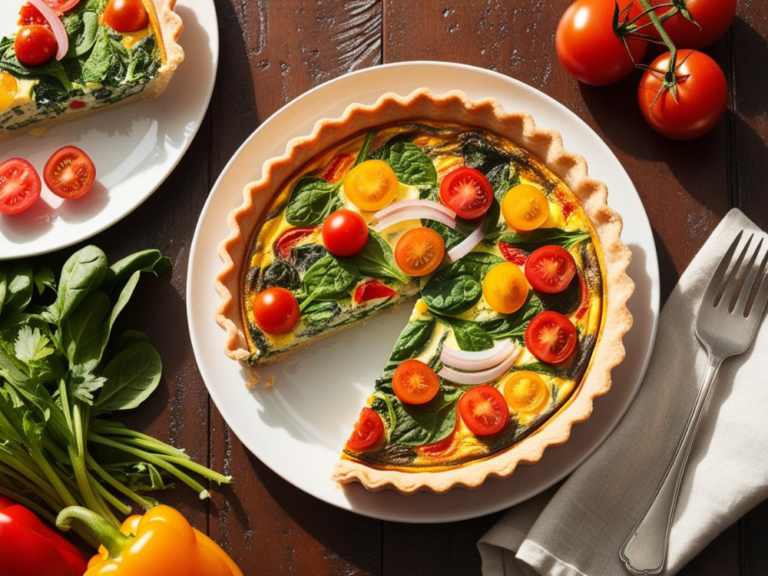
Perfect Pairings: What to Serve with Vegetable Quiche
One of the many reasons we love vegetable quiche is its versatility—it’s delicious on its own but also pairs beautifully with a variety of side dishes and drinks. Whether you’re planning a brunch, a light lunch, or a cozy dinner, choosing the right accompaniments can elevate your meal and create a balanced, satisfying experience. Let’s explore some perfect pairings for vegetable quiche that will delight your taste buds and impress your guests!
1. Fresh and Vibrant Salads
A crisp, refreshing salad is the ideal companion to the rich, creamy texture of a vegetable quiche. The lightness of greens balances the savory flavors of the quiche, making the meal feel complete without being too heavy.
- Mixed Greens with Vinaigrette: Toss together baby spinach, arugula, and romaine with a light lemon or balsamic vinaigrette for a zesty contrast.
- Mediterranean Salad: Combine cucumbers, cherry tomatoes, red onions, Kalamata olives, and feta cheese with olive oil and a squeeze of lemon for a flavorful pairing.
- Shaved Fennel and Citrus Salad: For a more gourmet touch, pair your quiche with thinly sliced fennel, orange segments, and a drizzle of honey-lime dressing.
2. Hearty Soups
Pairing a slice of vegetable quiche with a warm, comforting soup is a great way to create a well-rounded meal, especially during cooler months.
- Tomato Basil Soup: The tangy sweetness of a classic tomato soup complements the savory, creamy flavors of the quiche perfectly.
- Butternut Squash Soup: A creamy, slightly sweet soup balances the savory notes in the quiche while adding a cozy, autumnal feel.
- French Onion Soup: This rich, caramelized onion soup with its cheesy topping creates a decadent pairing for a light vegetable quiche.
3. Bread and Rolls
Adding a side of bread or rolls is a simple way to round out your meal while soaking up any leftover quiche filling on your plate.
- Crusty Baguette: A French baguette slices beautifully and adds a rustic touch to your table. Serve it plain or with a light spread of butter.
- Herb Focaccia: The aromatic flavors of rosemary or garlic-infused focaccia pair wonderfully with the quiche’s vegetables.
- Whole Grain Dinner Rolls: These are perfect for a heartier meal and bring a nutty flavor that complements the quiche.
4. Fresh Fruit and Yogurt
For a lighter, brunch-style pairing, fresh fruit and yogurt bring a touch of sweetness and balance to the meal.
- Seasonal Fruit Salad: Mix berries, melons, grapes, and citrus fruits for a colorful and refreshing side.
- Greek Yogurt with Honey: A dollop of creamy yogurt with a drizzle of honey and a sprinkle of granola adds a satisfying, sweet contrast.
- Grilled Peaches or Pineapple: For a warm, caramelized option, grilled fruits are a unique and delicious choice.
5. Roasted or Steamed Vegetables
If you’re serving vegetable quiche as part of a dinner, consider pairing it with extra roasted or steamed vegetables for a nutrient-packed plate.
- Roasted Asparagus: Drizzle asparagus spears with olive oil, sprinkle with salt and pepper, and roast them until tender and slightly crispy.
- Steamed Broccoli with Lemon: A squeeze of fresh lemon adds a bright, tangy flavor that complements the richness of the quiche.
- Honey-Glazed Carrots: Sweet, caramelized carrots add a subtle sweetness that pairs wonderfully with the quiche’s savory notes.
6. Drinks That Complement Quiche
The right beverage can enhance the flavors of your vegetable quiche and round out the meal. Here are a few drink pairings to consider:
- Coffee or Tea: For brunch, a strong cup of coffee or a pot of herbal tea (like chamomile or mint) is a classic choice.
- Mimosas: If you’re hosting a brunch, the light, bubbly sweetness of a mimosa is the perfect match for quiche.
- White Wine: A crisp, dry white wine like Sauvignon Blanc or Pinot Grigio pairs beautifully with the creamy texture and rich flavors of the quiche.
- Sparkling Water with Citrus: For a non-alcoholic option, sparkling water infused with lemon or lime is light and refreshing.
7. Sweet Endings for Dessert
If you’re serving vegetable quiche as part of a larger meal, finish things off with a simple, light dessert.
- Lemon Bars: The bright, tangy flavor of lemon bars is a refreshing contrast to the savory quiche.
- Berry Parfait: Layers of fresh berries, whipped cream, and granola provide a sweet but light ending to your meal.
- Dark Chocolate Squares: A few pieces of high-quality dark chocolate are a simple yet indulgent treat.
Conclusion
When it comes to pairing dishes with vegetable quiche, the possibilities are endless. From fresh salads to hearty soups, crusty bread, or even a sparkling drink, these pairings will elevate your meal and make it unforgettable. Whether you’re hosting a brunch or enjoying a cozy dinner, these combinations ensure that your vegetable quiche shines as the centerpiece of a well-rounded, delicious spread. Ready to give it a try? Check out the recipe and start planning your perfect pairings today!
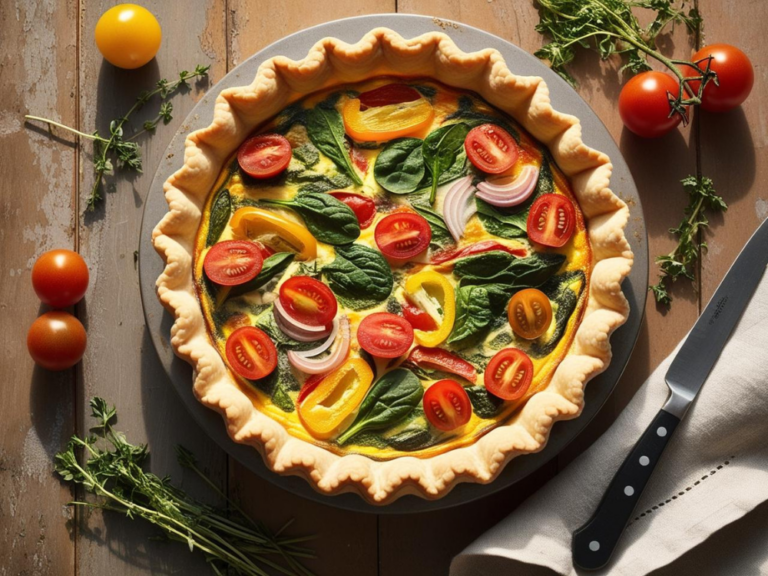
Frequently Asked Questions (FAQs) About Vegetable Quiche
Making a vegetable quiche is a delightful experience, but you might have a few questions before you dive into this classic dish. From troubleshooting common issues to tips for customizing the recipe, this FAQ section covers everything you need to know to make a perfect quiche every time. Let’s answer some of the most frequently asked questions about vegetable quiche!
1. What is a vegetable quiche?
A vegetable quiche is a savory pie made with a flaky crust and filled with a creamy custard mixture of eggs, milk (or cream), and various vegetables. Popular vegetables include spinach, cherry tomatoes, bell peppers, onions, and mushrooms. It’s versatile, easy to customize, and perfect for any meal of the day.
2. Can I make a crustless vegetable quiche?
Absolutely! A crustless vegetable quiche is a great option if you’re looking to reduce carbs or save time. Simply grease your pie dish or baking pan to prevent sticking, and pour the filling directly into the dish. It bakes beautifully and has all the flavor of a traditional quiche without the crust.
3. How do I prevent a soggy crust?
A soggy crust is a common concern when making quiche, but it’s easy to avoid with these tips:
- Blind bake the crust: Pre-bake the crust for about 10-15 minutes before adding the filling to ensure it stays crispy.
- Brush with egg wash: Before blind baking, brush the crust with a beaten egg to create a barrier that prevents the custard from soaking in.
- Use a sturdy crust: Opt for a high-quality pie crust that holds its shape and texture when baked.
4. Can I use store-bought crust?
Yes! Store-bought crusts are a convenient option if you’re short on time. Look for pre-made crusts in the refrigerated or frozen section of your grocery store. Just make sure to follow the packaging instructions for blind baking before adding your filling.
5. What kind of vegetables work best in a quiche?
The beauty of vegetable quiche is its versatility. Almost any vegetable can work, but here are some favorites:
- Leafy greens like spinach or kale (sautéed to reduce moisture).
- Cherry tomatoes for a burst of sweetness and color.
- Bell peppers for a crunch and mild sweetness.
- Mushrooms, which add an earthy flavor.
- Zucchini or asparagus for a light, fresh taste.
Make sure to cook or sauté vegetables with high water content, like mushrooms or zucchini, before adding them to the quiche to prevent excess moisture.
6. Can I add protein to my vegetable quiche?
Definitely! While the eggs already provide a good source of protein, you can enhance your quiche with other protein-rich ingredients:
- Diced cooked chicken or turkey.
- Crumbled bacon or sausage.
- Cubed ham.
- Plant-based proteins like tofu or tempeh for a vegetarian option.
7. How do I make my quiche dairy-free?
Making a dairy-free vegetable quiche is easy with a few substitutions:
- Replace milk or cream with plant-based alternatives like almond milk, oat milk, or coconut milk.
- Swap out cheese with a dairy-free cheese alternative or nutritional yeast for a cheesy flavor.
- Use olive oil or vegan butter for the crust if you’re making it from scratch.
8. Can I freeze vegetable quiche?
Yes, quiche freezes beautifully and is perfect for meal prep! Follow these tips for freezing:
- Before baking: Assemble the quiche, cover it tightly with plastic wrap and aluminum foil, and freeze. When ready to bake, thaw overnight in the fridge and bake as directed.
- After baking: Let the quiche cool completely, then wrap it tightly in plastic wrap and aluminum foil or place it in an airtight container. Reheat slices in the oven or microwave for a quick meal.
9. How long does quiche stay fresh?
When stored properly, quiche stays fresh for:
- In the refrigerator: Up to 4 days. Store it in an airtight container or cover it tightly with plastic wrap.
- In the freezer: Up to 3 months. Thaw overnight in the fridge before reheating.
10. Can I make quiche ahead of time?
Yes! Quiche is a great make-ahead dish. You can either:
- Bake it in advance and refrigerate it. Reheat slices in the oven at 350°F (175°C) for 10-15 minutes before serving.
- Assemble it in advance and store it in the fridge overnight. Bake it fresh the next day for the best texture.
11. What’s the best way to reheat quiche?
The best way to reheat quiche is in the oven:
- Preheat your oven to 350°F (175°C).
- Place the quiche (or individual slices) on a baking sheet and cover loosely with foil to prevent drying out.
- Heat for 10-15 minutes or until warmed through.
You can also reheat it in the microwave for about 1-2 minutes, but the crust may lose some of its crispiness.
12. What are some common mistakes to avoid when making quiche?
Here are a few tips to ensure your quiche turns out perfect every time:
- Don’t overfill the crust; leave a little room for the filling to expand as it bakes.
- Avoid underbaking—the custard should be set but still slightly jiggly in the center when you take it out of the oven.
- Sauté vegetables with high water content to prevent a watery filling.
- Use the right ratio of eggs to liquid (a common rule is 1 egg per ½ cup of milk or cream).
Conclusion
Making a vegetable quiche is easier than you think, especially when you know the answers to these frequently asked questions. From avoiding soggy crusts to customizing your fillings and storing leftovers, these tips will help you create a delicious and foolproof quiche every time. Ready to put these tips into action? Check out our full recipe and start baking today!
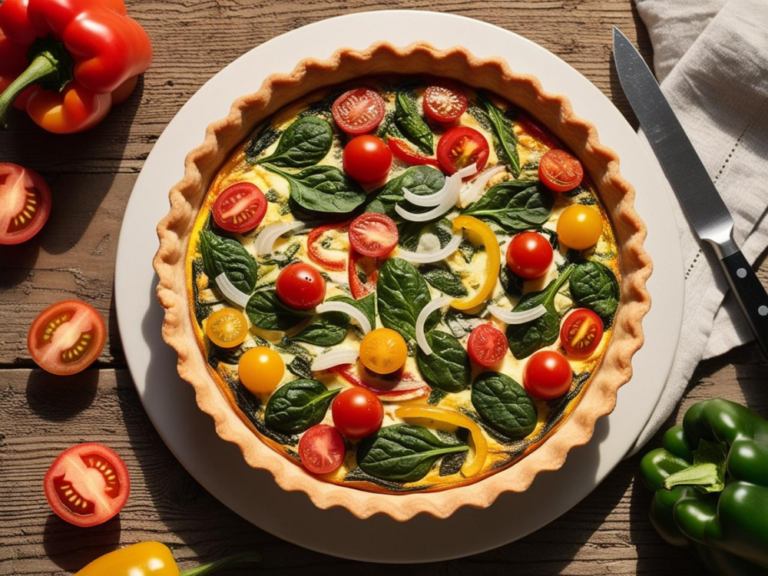
Common Mistakes to Avoid When Making Vegetable Quiche
Making a delicious vegetable quiche is a rewarding experience, but like any recipe, there are a few pitfalls that can trip you up. Whether it’s ending up with a soggy crust, a watery filling, or an overcooked quiche, these common mistakes can take the joy out of your culinary masterpiece. Don’t worry—we’ve got you covered! Here’s a detailed guide to help you avoid the most common mistakes and ensure your quiche turns out perfect every time.
1. Skipping the Blind Bake
One of the most common reasons for a soggy crust is skipping the blind baking step. Blind baking means pre-baking your crust before adding the filling. It helps create a barrier so the custard doesn’t soak into the crust. To do this:
- Line your crust with parchment paper or foil and fill it with pie weights, dried beans, or rice.
- Bake it at 375°F (190°C) for about 10-15 minutes until lightly golden.
This step ensures a crispy, flaky crust every time!
2. Not Cooking Vegetables Properly
Raw vegetables release a lot of water as they cook, which can lead to a watery quiche. To avoid this:
- Sauté or roast your vegetables before adding them to the quiche. This step reduces their moisture content and enhances their flavors.
- For leafy greens like spinach or kale, make sure to cook them down and squeeze out any excess water.
By cooking your vegetables properly, you’ll prevent a watery filling and ensure a more flavorful quiche.
3. Using the Wrong Egg-to-Liquid Ratio
Getting the custard texture just right is all about the right ratio of eggs to liquid. A good rule of thumb is:
- Use 1 large egg for every ½ cup of liquid (milk, cream, or a mix).
Too much liquid can make the custard runny, while too many eggs can make it rubbery. Stick to this ratio, and you’ll get that creamy, custard-like texture every time.
4. Overfilling the Crust
It’s tempting to pack your quiche full of filling, but overfilling can lead to messy spills and uneven cooking. Leave a little room (about ¼ inch) at the top of the crust to allow the custard to expand as it bakes. This will give you a perfectly set quiche without any overflow.
5. Overbaking the Quiche
A quiche that’s overbaked can turn out dry and rubbery instead of creamy and soft. To avoid this:
- Bake the quiche until the edges are set but the center is still slightly jiggly. It will continue to cook as it cools.
- Check for doneness around 35-40 minutes at 350°F (175°C), depending on the size and depth of your quiche.
Keep an eye on it, and don’t be afraid to take it out when the center has just a slight wobble—it’ll firm up as it rests.
6. Not Letting the Quiche Rest
Cutting into your quiche immediately after taking it out of the oven can cause the filling to fall apart. Let the quiche rest for at least 10-15 minutes before slicing. This allows the custard to set fully and ensures clean, beautiful slices.
7. Forgetting to Season the Filling
Under-seasoning is a common mistake that can leave your quiche tasting bland. Vegetables, in particular, need a good seasoning boost. Here’s how to get it right:
- Season each layer of your quiche (vegetables, custard, and cheese) with salt, pepper, and any herbs or spices you like.
- Add a pinch of nutmeg to the custard for a subtle depth of flavor—it’s a secret weapon in many traditional quiche recipes!
Well-seasoned ingredients are the key to a flavorful quiche.
8. Not Using the Right Bakeware
The type of dish you use to bake your quiche matters. A shallow pie pan or tart pan ensures even cooking and prevents the quiche from being undercooked in the middle. Avoid deep dishes unless you’re adjusting the recipe for a longer baking time.
9. Forgetting to Preheat the Oven
This one’s easy to overlook, but it’s crucial. Always preheat your oven to the specified temperature before putting your quiche in. Starting with a hot oven ensures the custard sets correctly and the crust bakes evenly.
10. Ignoring Customization Options
One mistake many people make is thinking they must stick rigidly to the recipe. The beauty of a vegetable quiche is how customizable it is! Don’t be afraid to swap ingredients based on your preferences or what you have in your fridge. For example:
- Add mushrooms, zucchini, or asparagus for extra veggies.
- Experiment with different cheeses like feta, goat cheese, or gruyère.
- Use fresh herbs like thyme, parsley, or chives for added flavor.
Making it your own is part of the fun, so don’t hesitate to get creative!
Conclusion
Avoiding these common mistakes will make all the difference in your vegetable quiche, ensuring a perfectly crisp crust, creamy filling, and rich, delicious flavor. With just a few extra steps and some attention to detail, you’ll create a quiche that’s worthy of a brunch centerpiece or a weeknight dinner star. Ready to put these tips into action? Head over to our recipe and start baking your best quiche yet!
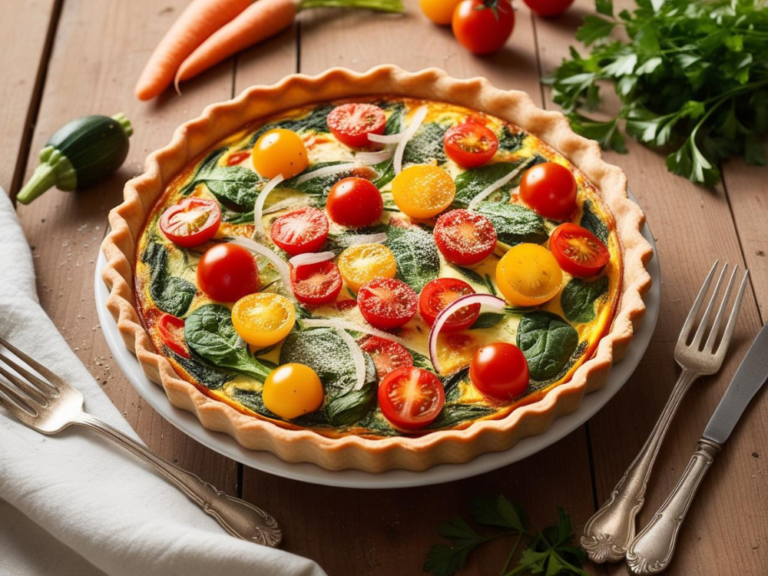
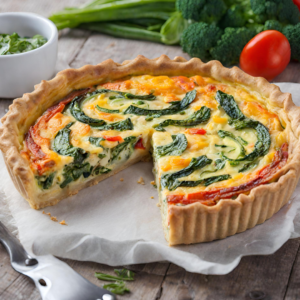
Vegetable Quiche
Equipment
- Mixing Bowls: For whisking the eggs and mixing the custard filling.
- Whisk or Fork: To blend the eggs, milk, and seasonings.
- Cutting Board and Knife: For chopping vegetables.
- Skillet or Pan: To sauté the vegetables before adding them to the quiche.
- Pie Dish: A 9-inch pie dish or tart pan to bake the quiche.
- Rolling Pin: If you’re making a homemade crust.
- Parchment Paper and Pie Weights: For blind baking the crust (optional but recommended).
- Measuring cups and spoons – For precise measurements of ingredients.
- Oven Mitts: To handle the hot pie dish.
- Wire Rack: To cool the quiche after baking.
Ingredients
- 1 Pre-made pie crust (or homemade if you're feeling adventurous)
- 4 Large eggs
- 1 Cup Heavy cream
- 1/2 Cup Milk
- 1 Cup Shredded cheddar cheese
- 1/2 Cup Finely chopped onions
- 1 Cup Chopped vegetables (broccoli, bell peppers, and mushrooms work great)
- 1/2 Tsp Salt
- 1/4 Tsp Black pepper
- 1 Tbsp Olive oil
- 1/4 Tsp Nutmeg for a hint of warmth (Optional)
Instructions
- Preheat your oven to 375°F (190°C). This ensures a perfectly cooked quiche with a golden-brown crust.
- Prepare the Vegetables: In a pan, heat the olive oil over medium heat. Sauté the onions until translucent, then add the rest of the chopped vegetables. Cook until they're just tender. This step brings out their natural sweetness and ensures they are perfectly cooked within the quiche.
- Whisk it up: In a large bowl, combine eggs, heavy cream, milk, salt, pepper, and nutmeg (if using). Whisk until the mixture is smooth. This is the custard base that makes the quiche so irresistibly creamy.
- Layering: Spread the sautéed vegetables evenly on the bottom of the pie crust. Sprinkle the shredded cheese over the vegetables. Pour the egg mixture over the cheese. The cheese layer beneath the custard adds a delightful surprise of texture and flavor.
- Bake: Place the quiche in the preheated oven and bake for 35-45 minutes, or until the custard is set and the top is lightly golden. To test for doneness, insert a knife in the center – it should come out clean.
- Cool & Serve: Let the quiche cool for at least 10 minutes before slicing. This rest period helps the quiche set, making it easier to cut and serve.
Notes
Make-Ahead Tips
-
Prepare the Quiche in Advance (Unbaked)
- Assemble the quiche with the crust, filling, and custard, then cover it tightly with plastic wrap or aluminum foil.
- Store it in the refrigerator for up to 24 hours before baking.
- When ready to bake, remove it from the fridge, uncover, and bake as directed. You may need to add 5-10 minutes to the baking time if it goes straight from the fridge to the oven.
-
Bake the Quiche Ahead of Time
- Fully bake the quiche, let it cool to room temperature, and then cover it tightly.
- Store it in the refrigerator for up to 4 days or freeze it for longer storage (see below).
- Reheat individual slices or the whole quiche before serving.
Storing Leftover Quiche
-
In the Refrigerator
- Once cooled, wrap the quiche tightly in plastic wrap or transfer it to an airtight container.
- Store it in the fridge for up to 4 days.
-
In the Freezer
- Quiche freezes beautifully! To freeze, follow these steps:
- Let the quiche cool completely.
- Wrap the entire quiche or individual slices tightly in plastic wrap, then in aluminum foil to prevent freezer burn.
- Place it in a freezer-safe bag or airtight container.
- Frozen quiche can be stored for up to 3 months.
- Quiche freezes beautifully! To freeze, follow these steps:
Reheating Quiche
-
From the Refrigerator
- Preheat your oven to 350°F (175°C).
- Cover the quiche loosely with foil to prevent it from drying out.
- Heat for 10-15 minutes for slices or 20-25 minutes for a whole quiche until warmed through.
- For a quick option, microwave individual slices for 1-2 minutes, though the crust may lose some crispiness.
-
From the Freezer
- Thaw the quiche overnight in the refrigerator for the best texture.
- Reheat in the oven at 350°F (175°C) as directed above.
- If you’re in a rush, reheat directly from frozen, adding 10-15 extra minutes to the baking time.
Quick Tip
To keep the crust crispy when reheating, place the quiche on a baking sheet rather than directly on the oven rack. This ensures the heat circulates evenly and maintains the texture of the crust.With these make-ahead and storage tips, you’ll always have a delicious vegetable quiche ready for any occasion—whether it’s a quick breakfast, a weekday lunch, or a last-minute dinner!
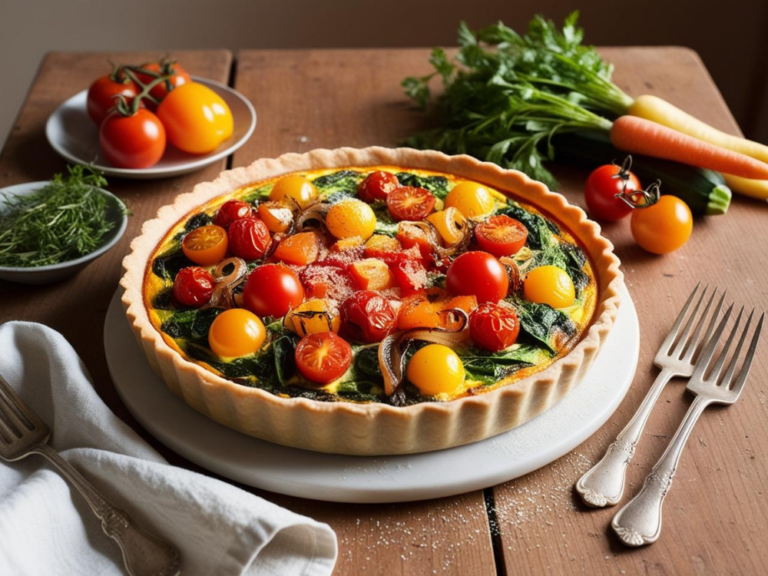
Bring a Touch of Comfort to Your Table
There’s something truly special about making and sharing a dish like vegetable quiche. It’s more than just a recipe—it’s a comforting meal that brings people together, whether you’re enjoying a quiet breakfast at home or hosting a lively brunch with friends and family. Its versatility, vibrant flavors, and homemade charm make it a staple for any occasion.
As you bake your quiche, don’t forget to savor the process. From whisking the creamy custard to layering in colorful vegetables, every step adds a personal touch that makes the final dish uniquely yours. So go ahead, gather your ingredients, preheat your oven, and let your kitchen fill with the warm, inviting aroma of quiche. Here’s to creating something delicious, wholesome, and worth sharing. Happy baking!
Join Now!
Love this recipe? Don’t miss out on even more delicious, healthy, and easy-to-make recipes like this vegetable quiche! By joining our email community, you’ll gain access to exclusive content, bonus recipes, and tips to make clean eating a breeze.
Enter your email & click below to subscribe and start receiving tasty inspiration right away. It only takes a minute to join our growing community of food lovers dedicated to making healthy eating delicious and fun.

